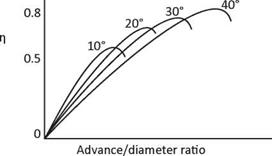Advance/Diameter Ratio
The aircraft designer has to choose the propeller with the most suitable pitch and diameter for the aircraft and its intended mission and design air speed. When confronted with a family of props which have their blade angles increasing in some systematic order, one useful parameter to refer to is the advance/diameter ratio. The advance/diameter ratio can be used to define the characteristics of a prop using a nondimensional form. The advance/diameter ratio (J) is the ratio of the aircraft’s velocity (TAS) to the product of propeller RPM and diameter
V
The advance/diameter ratio, J = ^
Where, V = true air speed N = RPM
D = propeller diameter
Diagram 6, Advance/diameter Ratio shows the curve for the advance/diameter ratio plotted against efficiency for a family of props with their pitch increasing. The numbers above the curves shows the blade angles for each propeller. The efficiency increases with an increase in the ratio up to a certain limit. At too high a ratio, the angle of attack of the blades exceeds the stalling angle at low forward speeds reducing the thrust available for take-off. Reducing the propeller’s diameter also reduces the efficiency by over working the prop blades, but more of this later. A fixed-pitch propeller’s efficiency curve moves to the left with a decrease in RPM and TAS and to the right with an increase of RPM and TAS power. Diagram 6, also shows the curves for a fine/flat pitch prop and a coarse pitch prop, 10 and 40 degrees respectively. Most single-engine light aircraft have a prop between these two extremes A constant speed propeller has an infinite number of curves between the fine and coarse pitch limit stops; the pilot selects the optimum setting for climb or cruise.
Slip function and effective pitch are alternate names for the advance/diameter ratio
|
Diagram 6, Advance/diameter Ratio |












